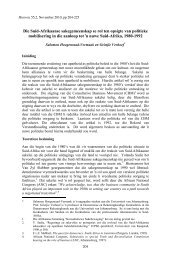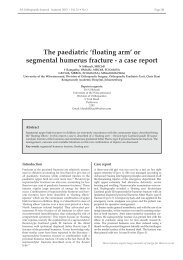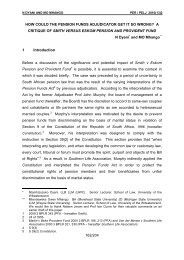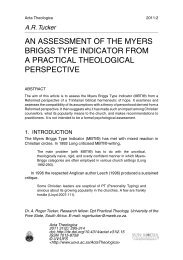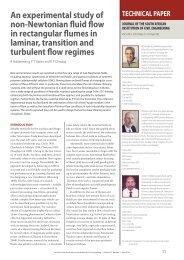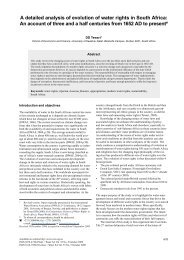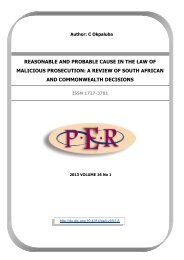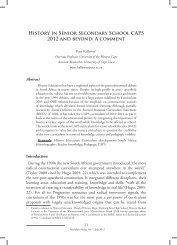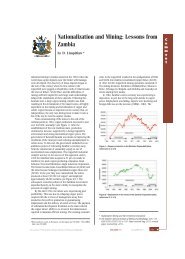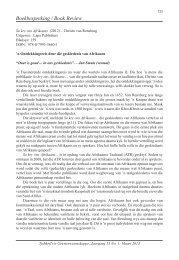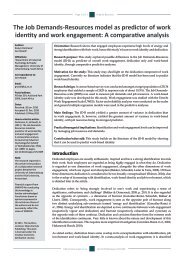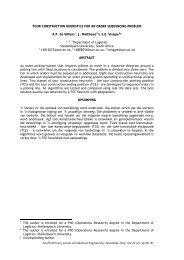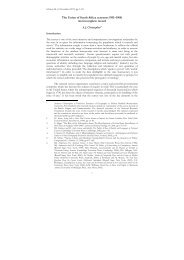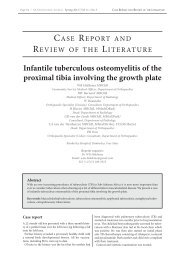Frances Baard's and Helen Joseph's struggle against apartheid ...
Frances Baard's and Helen Joseph's struggle against apartheid ...
Frances Baard's and Helen Joseph's struggle against apartheid ...
Create successful ePaper yourself
Turn your PDF publications into a flip-book with our unique Google optimized e-Paper software.
Musiiwa - <strong>Frances</strong> Baard’s <strong>and</strong> <strong>Helen</strong> Joseph’s <strong>struggle</strong><br />
taking is good rapport. More often than not, the researcher takes the initiative to<br />
establish a relationship with the narrator, <strong>and</strong> at times this involves the establishment of<br />
fictive kinships.<br />
Although the narrator <strong>and</strong> the researcher establish rapport, the act of telling the<br />
story temporarily shifts power to the narrator. What the narrator says depends largely on<br />
what the narrator remembers or wishes to talk about. The narrator has the power to<br />
select, recollect, <strong>and</strong> restructure her interpretations of the past. Schreiner admits that the<br />
story,<br />
based on hours of interviews <strong>and</strong> discussions, is told in the words of <strong>Frances</strong> Baard<br />
herself. It is one person’s view, the story of a woman deeply <strong>and</strong> sincerely involved in the<br />
daily events of a nation’s <strong>struggle</strong> for freedom. 31<br />
However, as Gluck notes, “The perspective of the interviewer cannot help but influence,<br />
even subtly, the content of the material – particularly what the interviewee will judge as<br />
important. 32 For instance, Schreiner thanks Baard “for her patience with my endless<br />
questions”. 33 In short, the nature of the questions posed by the researcher instigate the<br />
direction of the story. In comparison, <strong>Helen</strong> Joseph seems to respond to anonymous<br />
questions from a perceived audience about women’s role in anti-<strong>apartheid</strong> activism. She<br />
is limited to presenting the story of the anti-<strong>apartheid</strong> <strong>struggle</strong> as she herself underst<strong>and</strong>s<br />
it.<br />
For the life historian <strong>and</strong> autobiographer, telling is marked by historical context<br />
<strong>and</strong> shaped by available cultural modes. Watson <strong>and</strong> Watson-Franke note that the details<br />
of economics, politics, family structure <strong>and</strong> general ideological orientation allow us to<br />
comprehend the meaning of events <strong>and</strong> experiences that a personal narrative describes. 34<br />
Gluck notes that:<br />
the life of the interviewer is reconstructed within a broader social context – a context not<br />
ordinarily provided by the self-recorded memoirist. An underst<strong>and</strong>ing of this context<br />
guides the interviewer in deciding which spontaneous material should be elaborated on<br />
more fully. 35<br />
With reference to women, Belinda Bozzoli notes that “women make their own narratives<br />
(<strong>and</strong> life histories) but they do so under conditions not of their own choosing. Both<br />
individual agency <strong>and</strong> structure must be considered”. 36<br />
Editing of the narratives tends to determine what gets to be finally textualised.<br />
The subordinate role of the collector shifts during the time of editing a life history. The<br />
editor exercises substantial power over the narrator because she records, transcribes, <strong>and</strong><br />
translates the interviews. The editor has the power to determine what to leave out in<br />
order to come up with a story. Researchers/editors also wield the power to choose<br />
subtitles <strong>and</strong> organise information into chapters, <strong>and</strong> have final authority in the<br />
formation <strong>and</strong> publication of a narrative while an autobiographer edits her own work. In<br />
both cases the writer has the historical advantage <strong>and</strong> final say in the process of “selective<br />
recall” for what is, <strong>and</strong> what is not included in the text, <strong>and</strong> the form the written text<br />
31. Baard <strong>and</strong> Schreiner, My Spirit is not Banned, “Introduction”.<br />
32. Gluck, “What’s so Special about Women?”, p 6.<br />
33. Baard <strong>and</strong> Schreiner, My Spirit is Not Banned, “Introduction”.<br />
34. Watson <strong>and</strong> Watson-Franke, Interpreting Life Histories, p 4.<br />
35. Gluck, “What’s so Special about Women?”, p 6.<br />
36. Bozzoli, Women of Phokeng, p 5.<br />
71



